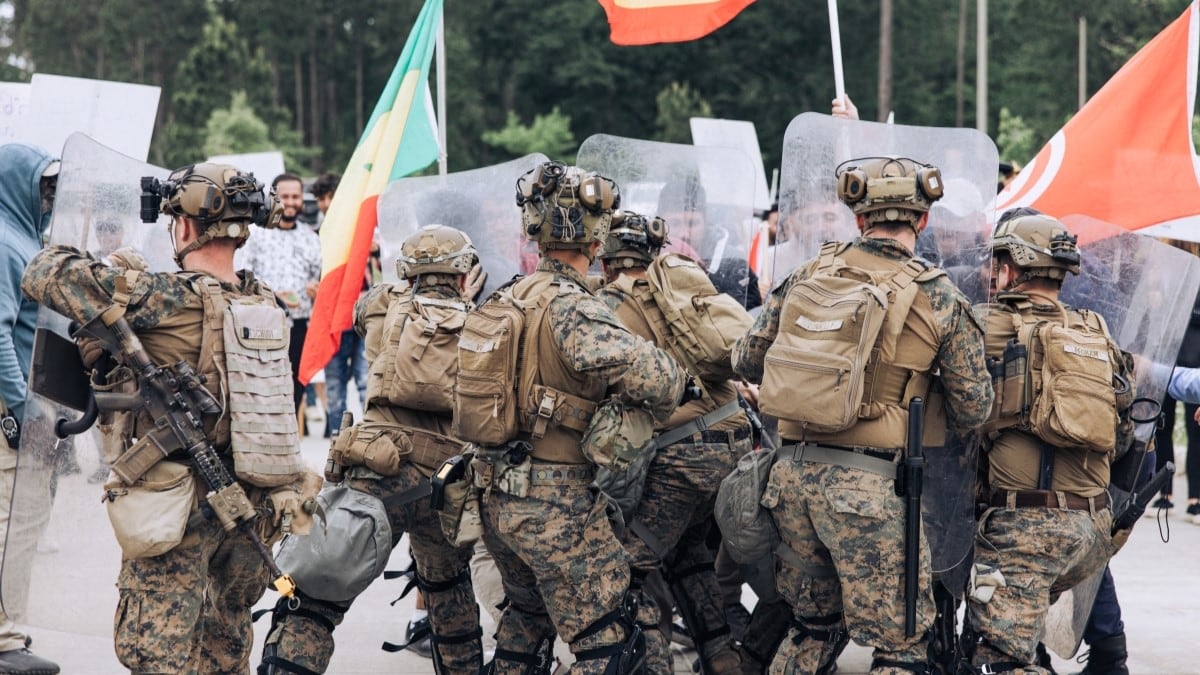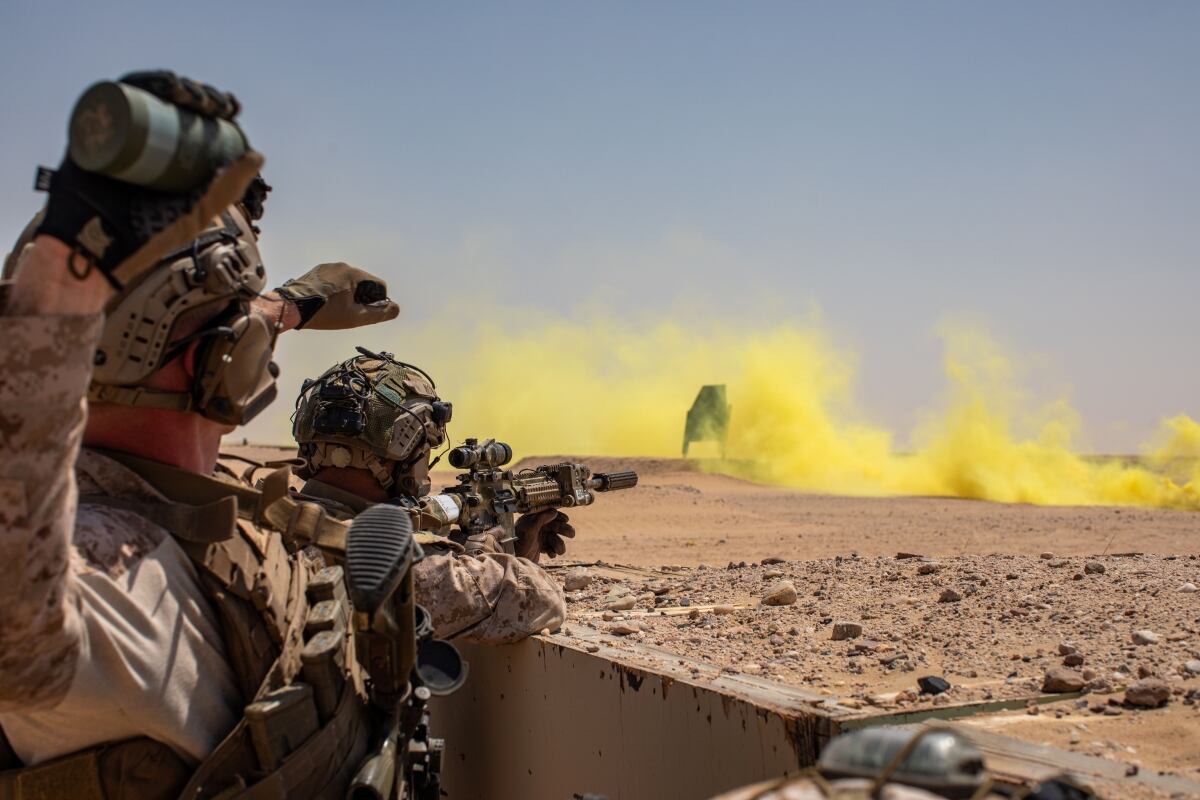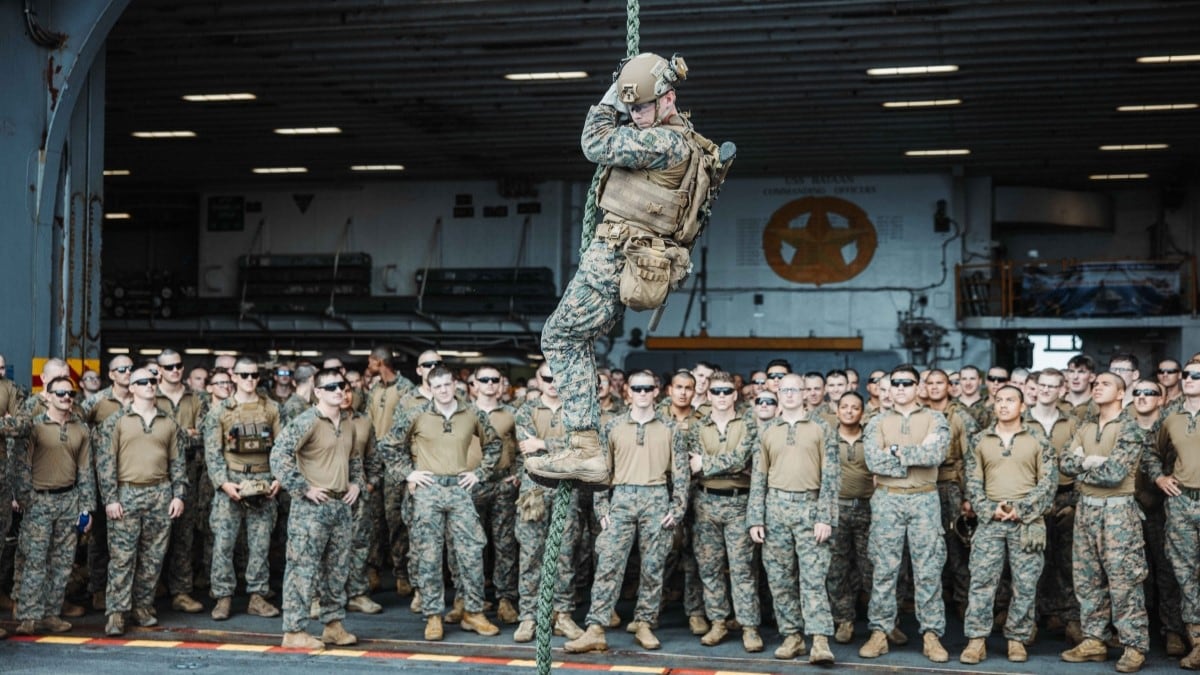The Marine Corps’ expeditionary unit capable of special operations has departed early from a scheduled exercise with Kuwait “as a result of a emerging events,” days after war broke out in the Levant following a deadly attack on Israel by a Palestinian militant group.
Among those killed in Hamas’ surprise attack on Israel Saturday were at least 22 U.S. citizens, with at least 17 still unaccounted for on Wednesday. Hamas is holding some Americans hostage in Gaza, according to the White House.
When the Israel-Hamas war broke out, elements from the special operations capable 26th Marine Expeditionary Unit already were forward-deployed in the Middle East ― in the Persian Gulf nation of Kuwait rather than in the Mediterranean.
But those Marines and sailors, who have been traveling on the amphibious assault ship Bataan and the dock landing ship Carter Hall, “are no longer in vicinity of Kuwait,” Capt. Angelica White, a spokeswoman for the unit, told Marine Corps Times on Wednesday.
The Marines and sailors received orders to get back on their ships within 48 hours after disembarking in Kuwait “to prepare for further tasking as a result of a emerging events,” White said in an emailed statement.
They are now in the vicinity of Bahrain, according to the spokeswoman.
White declined to specify where the ships were headed next, citing operational security concerns. Her statement did not confirm whether the events in question were those in Israel and Gaza.
White added in an email to Marine Corps Times a few hours after this story was published that the 26th Marine Expeditionary Unit had not yet been tasked with supporting a particular mission but rather “is posturing our force in effort to be prepared” so that “in the case that we are tasked or directed, we are able to respond promptly.”
In that follow-up email, the spokeswoman declined to speculate on any future tasking and direction of the unit and the amphibious ready group, as the naval element is called, because of operational security.
“As a crisis response force, we stand ready,” White said.
The Navy’s Ford carrier strike group arrived Tuesday in the Eastern Mediterranean as “a strong signal of deterrence should any actor hostile to Israel consider trying to take advantage of this situation,” Army Gen. Michael “Erik” Kurilla, commander of U.S. Central Command, said in a news release. The Eisenhower carrier strike group is heading toward Europe on Friday as part of a scheduled deployment.
“We stand ready to move in additional assets as needed,” President Joe Biden said in a speech Tuesday in which he condemned Hamas as “sheer evil.”
What is the 26th Marine Expeditionary Unit (Special Operations Capable)?
The Corps’ Marine expeditionary units are groups of more than 2,000 Marines and sailors, embarked across three amphibious ships operated by the Navy, who are forward-positioned abroad in case emergencies arise.
In August 2021, for instance, the 24th Marine Expeditionary Unit already was in the Middle East as the Taliban approached Kabul and the United States worked to evacuate Americans and Afghan allies from Afghanistan. Marines from that unit were some of the first to deploy to Kabul to assist in the evacuation.
In 2023, however, Marine expeditionary units didn’t provide support to Turkey following a devastating earthquake in February or assist in the evacuation of Americans from the Sudanese embassy in April. Marine leaders have said a dwindling number of amphibious ships hamstrung the Corps’ ability to respond quickly to those regional crises.
The 26th Marine Expeditionary Unit is the first Marine expeditionary unit with the special operations capable designation in more than a decade, according to the unit. It has approximately 2,400 Marines and sailors from II Marine Expeditionary Force, the Corps’ North Carolina-based force.
Back in 1985, the unit’s predecessor, the 26th Marine Amphibious Unit, was the very first to be designated special operations capable. The 26th Marine Expeditionary Unit received that designation again in July.
The special operations capable designation means service members in the unit received enhanced training before their deployment, practicing the recovery of aircraft and people, raids, stealthy insertion and extraction of special patrols, maritime interdiction and noncombatant evacuations, according to the release. The unit doesn’t contain Marine Raiders, the Corps’ special operators, but the unit’s Maritime Special Purpose Force practiced integrating with special operators, including Navy SEALs, White noted.
The 26th Marine Expeditionary Unit is meant to complement, not duplicate, special operations forces’ capabilities, according to White. The unit’s capabilities are “complementary and in support of” geographic combatant commanders, the Navy’s numbered fleets and the Joint Force, White said.
In training, the Marines and sailors in eastern North Carolina ran through scenarios involving evacuations of U.S. personnel from the fictitious coastal nation of Obsidian as protestors surrounded the “consulate” — all while Americans were being evacuated from Sudan in real life.

Marines from the unit even trained with the FBI’s hostage rescue team on tactics for close-range environments.
What has the 26th Marine Expeditionary Unit been up to?
In May, in the midst of training, 17 Marines from the expeditionary unit’s low-altitude air-defense detachment were deployed on short notice to Kuwait in support of U.S. Army Central, the Army formation focused on the Middle East and surrounding countries, Marine Corps Times previously reported.
“The 26th MEU LAAD served as a link in a chain of layered air defense programs, systems and capabilities designed to defeat adversary Unmanned Aerial Systems within the U.S. CENTCOM Area of Responsibility,” White told Marine Corps Times in June.
The Marine Corps has remained tight-lipped about the specific impetus for that deployment.
After the 26th Marine Expeditionary Unit’s full deployment kicked off in July, more than 100 Marines from the unit received training on how to protect commercial vessels transiting the strategically important Strait of Hormuz from harassment by Iran, the U.S. Naval Institute reported, citing an anonymous U.S. official.
But deputy Pentagon Press Secretary Sabrina Singh said Sept. 7, “There’s no plan right now for Marines to go on commercial vessels.”
The Marines and sailors from the unit aboard the amphibious transport dock Mesa Verde have been in Europe, stopping in Norway and Latvia for training exercises, according to news releases from the unit. On Oct. 4, the Mesa Verde docked in Cartagena, Spain, for mid-deployment maintenance.
Meanwhile, the amphibious assault ship Bataan and the dock landing ship Carter Hall have been in the Central Command region.

On Sunday, the Marines and sailors who have been traveling on those ships kicked off a bilateral exercise with Kuwaiti forces on Kuwaiti military bases, following two small-scale exercises with Kuwait involving an element from the Marine unit. The latest exercise had been slated to end Oct. 22, according to a news release from the unit.
Then, however, came the “emergent tasking” that prompted Marines and sailors to get aboard the amphibious ships once more.
The news release about the exercise, published a day after Hamas’ attack, didn’t directly address the war in Israel and Gaza.
But the commanding officer of the 26th Marine Expeditionary Unit, Col. Dennis “Dolf” Sampson, said in the release, “this exercise comes at an opportune time to truly showcase the relevance and operational capabilities of the 26MEU(SOC).”
Editor’s note: This story was updated Wednesday with additional context from the 26th Marine Expeditionary Unit’s spokeswoman.
Irene Loewenson is a staff reporter for Marine Corps Times. She joined Military Times as an editorial fellow in August 2022. She is a graduate of Williams College, where she was the editor-in-chief of the student newspaper.





